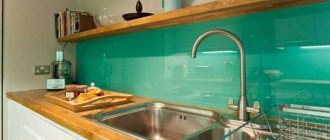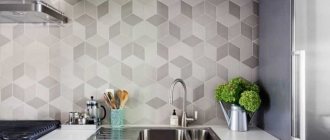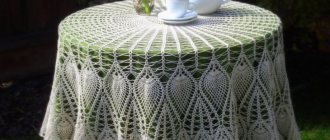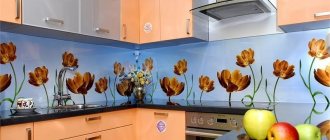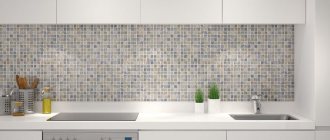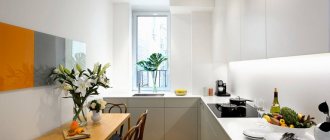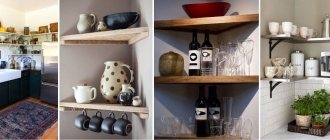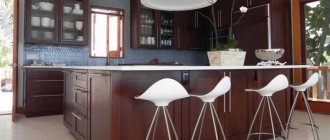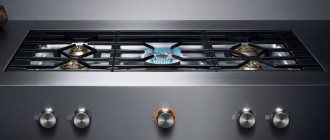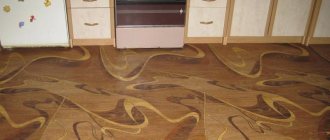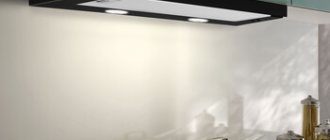The kitchen apron is considered one of the most important and noticeable interior details of this room. The finishing features and color scheme of the part of the wall between the countertop and wall cabinets often become almost key in the overall design solution of the kitchen. Experts advise approaching the issue of choosing a color for a kitchen apron no less carefully than choosing the material for its design.
Photo:
Gray apron in wenge kitchen with white
Why do you need a kitchen apron?
The purpose of a kitchen apron is to protect the wall from the aggressive effects of hot oil, hot steam and grease. Its material allows you to easily clean the surface using available means.
Advantages of a kitchen apron:
- protecting the wall from grease, moisture and dust;
- additional element of room design;
- The apron can be changed if you want to quickly update the interior.
You don’t have to completely give up on a kitchen apron. Even if your budget is limited, you can choose a beautiful model made of plastic or MDF.
How to choose an apron for the kitchen
A kitchen panel is not only a decorative item, but also an important practical element, therefore, first of all, you need to pay attention to the quality of the material.
The kitchen apron must be resistant to high humidity, high temperatures and possible physical impact, for example, if you accidentally hit the wall.
Apron area dimensions
To calculate the height of the apron, you need to measure the distance between the top edge of the desktop and the wall cabinet.
Standards that must be taken into account when determining the size:
- minimum height – 50 cm. It is recommended to maintain a height of 65 cm above the hob;
- the width is strictly equal to the width of the kitchen unit;
- on each side it is necessary to maintain a margin of 3 cm.
When laying a tile backsplash, it is necessary to take into account the standard size of the cladding.
Tips for choosing an apron
To avoid making a mistake when choosing an apron, you should follow some tips:
- Particular attention is paid to the choice of colors. The apron should be harmoniously combined with the walls, floor and ceiling in the kitchen.
- It is important that when constantly looking at the apron your eyes do not get tired. It is better to choose calm, neutral shades.
- To better protect the apron from dust and dirt, you can coat it with an additional layer of gloss.
- If the kitchen is small, you should not put a bulky, bright image on the apron.
- You can visually expand the kitchen with the help of an apron if you apply a pattern with horizontal stripes to it.
- If tiles are chosen for installation, it is better to give preference to even squares - this way the apron will look stylish and expensive.
- A common mistake that is made when laying a backsplash is the lack of an additional row, which is why the pattern is cut off after installing the baseboards.
By following these tips, you can choose not only a beautiful, but also a practical apron for the kitchen.
Top 5 types of aprons
The most popular today are kitchen aprons made of glass (skinali), artificial stone, plastic and MDF. Also, the classic – ceramic tiles – never goes out of style. All types are good in their own way. To understand which one best suits personal preferences and financial capabilities, we suggest studying the comparative characteristics.
Glass
The kitchen apron is made of tempered glass - it is very durable and easy to clean. With its help you can implement almost any design solution. For example, using transparent glass, emphasize the beauty of wall decoration, or place decorative film with photo printing, dried flowers, or children's drawings between two glasses. For finishing you can choose frosted glass, textured, colored and even mirrored. There are plenty of options.
We recommend: The best and worst apartment layouts – you need to know what to buy!
Advantages of a glass apron:
- has an aesthetic appearance;
- many design variations;
- hygienic;
- durable,
- lasting;
- heat resistant.
Flaws:
- easily soiled;
- expensive;
- relatively fragile.
MDF apron
A budget option, but at the same time quite practical. An MDF (medium density fibreboard) backsplash is often included with kitchen units. You can also choose it separately; the product is quickly manufactured and easy to install. There are also many color variations: stone finishes, mosaics, tiles, drawings, photo printing, etc.
Advantages of MDF apron for the kitchen:
- low price;
- easy installation and dismantling;
- quite moisture resistant and durable;
- hygienic;
- universal, suitable for almost any stylistic solution.
The main disadvantage of such an apron is its low heat resistance. If a gas stove is placed nearby, in the event of a fire, the fire will spread quickly. The second disadvantage of the material is its tendency to deform. It cannot be called durable; its service life ranges from 5 to 10 years.
Ceramic tile
The tiled apron is a leader in practicality and price/quality ratio. Many will call this option old-fashioned - and they will be wrong. Today there are so many types of tiles that they can satisfy the most demanding taste: mosaic, textured, voluminous, with a metal coating, intricate patterns, embossing (for example, leather), large and small, combined sizes. The list can be endless. Let’s move on to the advantages of a ceramic tile backsplash:
- hygienic – does not stain, is easy to clean, does not absorb moisture and fat;
- heat-resistant – does not burn, does not melt;
- diverse - with it you can bring to life a lot of decor ideas;
- durable - does not scratch, does not leave dents;
- durable – service life from 15 to 50 years;
- completely safe - does not accumulate static electricity, does not conduct current.
There are few disadvantages to tiles:
- complexity of dismantling and installation;
- the need to level the wall before work;
- the presence of seams between the tiles, which reduce hygiene and require additional care.
Plastic
The characteristics of a plastic apron are comparable to those of MDF. It often comes complete with furniture, comes in a variety of shapes and shades, and is easy to install. There are several types: carbonate glass, PVC panels, vinyl, lining and laminate. But if the first two materials are considered relatively durable, hygienic and safe, then using the rest for installation next to the hob is simply reckless. Not only can they burst into flames instantly, but they are also easily deformed by temperature changes, and when heated, they release toxic substances into the air.
Apron made of liquid artificial stone
One of the most expensive aprons for the kitchen. Its undoubted advantages are the ability to create a single composition with the countertop and sink and easy restoration. Scratches or other defects are eliminated with the same putty from which the apron is made. It is made from acrylic or quartz agglomerate. The first is essentially plastic, is flammable and easily deteriorates. But quartz agglomerate really deserves attention. He is afraid of only one thing - bleach (loses color).
We recommend: Selecting whetstones and stones for sharpening knives
Advantages:
- hygienic;
- lasting;
- durable;
- “expensive” in appearance;
- heat resistant;
- easy to restore;
- can be connected to the tabletop without a seam.
Flaws:
- high price;
- installed only by specialists;
- limited choice of colors.
How to choose an apron for the kitchen by color and texture
In order not to make a mistake when choosing an apron by color, you should consider several recommendations:
- The first rule is that the chosen apron must be combined with the interior.
- You should not choose bright shades - they quickly tire your eyes. The ideal option is neutral colors with 1-2 bright accents.
- The texture of the apron can also affect the color intensity - to reduce brightness, you should choose a matte finish. Glossy surfaces are always much brighter.
- It is not recommended to choose an apron with a massive print for a small kitchen.
To easily and quickly select a suitable apron, you should determine the overall color scheme of the kitchen and understand which color predominates, and then select the details.
Apron for a white kitchen
Choosing an apron for a kitchen decorated in white should be based on its style. For high-tech style, the best option is gray shades: chrome, metallic. You can use durable metal panels.
If the kitchen is decorated in a simpler, classic version, it is recommended to use unusual mosaic tiles. You can combine 2-3 different shades to add color to a white room.
A budget option is to install a plastic apron in black, red, green or blue.
Gray kitchen
Gray is a beautiful and noble color, but many people find it quite boring. To avoid excessive monotony, you can dilute the gray with one of your favorite shades:
- blue;
- red;
- pink;
- yellow.
It is important to consider the type of shade of gray - it can be warm or cold. You can only add cold to cold - blue or pale pink.
You can brighten up a gray kitchen by using a bright glass panel with patterns. In this case, it is important that the composition is complemented by geometric shapes, and not mono-colors.
Cappuccino color
It may seem that choosing color accents for a cappuccino-colored kitchen is difficult, but this is only at first glance. The main rule is to stick to calm, elegant shades. Brown should not be diluted with neon orange or red. You can add unusual, beautiful lighting to make the kitchen sparkle with new colors.
You can use white, gray or pale yellow without allowing the added tint to overwhelm the cappuccino color.
Red kitchen
Red color is considered demanding and complex, however, choosing additional color accents for it is quite simple.
Can be used:
- brown;
- blue;
- white;
- grey;
- black.
Designers most often give preference to white or black aprons for a red kitchen - they look appropriate and do not spoil the interior.
If you decide to use white, it is recommended to lay the tiles as a solid, single sheet, without resorting to the “checkerboard” technique.
Lilac kitchen
Lilac color is considered sophisticated and light, therefore, when choosing additional accents for it, it is important not to overdo it. Ideal option: white, blue, pale gray or pink.
If you need to choose a brighter, dominant shade, you should use dark purple tiles. Another option is a dark gray metal panel or gray tiles, however, in this case it is necessary to choose household appliances to match.
Black and white kitchen
A kitchen decorated with a combination of two colors – black and white – is already “finished” in itself. All you need to do is add one or two bright color accents, one of which could be a kitchen apron.
The ideal option is a plastic apron in blue, yellow or gray. You can also install a metal panel, or choose a multi-colored mosaic.
Turquoise kitchen
Despite the fact that turquoise color is considered fashionable, it requires careful approach. It is important not to interrupt the beautiful shade by adding inappropriate details. Ideal color combinations: beige, white or gray.
Light pink tiles can be used with caution. It is not recommended to use bright colors, as you can end up with an eye-catching combination. If it’s difficult to make a choice, you can opt for pastel shades - they gently emphasize the beauty of turquoise without overpowering it.
Brown kitchen
Any shade of brown looks very beautiful in the kitchen, but choosing bright color accents to match it can be difficult.
If the entire kitchen is decorated in only one shade of brown, you can use another - lighter or darker. Another option is to choose tiles or panels in emerald green, olive, blue or white.
Apron made from skinali
Skinali
— panels made of tempered glass, which are very often used as a kitchen apron.
Such panels are made transparent, mirror or colored. Moreover, any design can be applied to the panel.
An example of a simple apron made from skinali without photo printing
An example of an apron made from skinali with a pattern
An example of a plain apron made from skinali
One of the advantages of the skinal is that when using a simple transparent panel (without photo printing), the finishing of the kitchen walls, be it wallpaper or painting, remains visible.
Skinali allow you to smooth the transition between the kitchen and living room.
One square meter of tempered glass will cost at least 3,500 rubles
. If you want to use clarified glass, this will increase the cost of the product by about 1.5 times. Photo printing leads to an increase in price by 20-30%. Also, some companies charge a separate fee for cutting holes for sockets and fasteners. So a kitchen apron made from skinny is quite expensive.
The panels are suitable for decorating a backsplash in a small kitchen. For installation, special fasteners or glue are used. Skinals are attached only to a perfectly flat surface. If you install panels on crooked walls, the glass may break in the future.
Skinali is a great option for those who don’t want kitchen renovations to take forever. Installing the panels will not take much time if you do not have to first level the walls.
The big disadvantage of glass panels is that they become easily soiled. The panels will have to be washed and rubbed regularly with special products.
Which apron to choose for a small kitchen?
If the size of the kitchen is small, you need to carefully choose an apron so as not to make the room visually even smaller than it originally looked. The most common mistake made when decorating is choosing large tiles, bright, neon patterns and panels with large details.
The following options are suitable for a small kitchen:
- glass or mirror panel;
- small mosaic tiles;
- panels made of natural wood, veneer;
- glossy panels.
You can also lay out laminate or tiles, the main thing is to maintain a horizontal position.
How much does a kitchen apron cost?
The price of kitchen aprons depends on many factors: the quality of the material, the complexity of manufacturing and the type of material. The most budget models are plastic tiles and wooden panels. They can be purchased at construction stores independently at standard prices. A regular plastic cover can be bought for 300-400 rubles. The price for higher quality products starts from 1000 rubles per sq.m.
The most expensive are 3D aprons and mosaic aprons, which must first be assembled according to a previously prepared drawing. The average price of a glass apron with photo printing is 5,000 rubles.
Choosing a kitchen apron is not an easy, but interesting task. If you take into account all the nuances and characteristics, choose high-quality material and choose a beautiful shade, then an apron can not only change the appearance of the entire kitchen, but also add chic and gloss to the room.
If you find an error, please select a piece of text and press Ctrl+Enter.
Mosaic apron
Mosaic
- facing slabs consisting of small parts that are fixed to the base in the form of paper or mesh
An example of a grid holding mosaic elements.
Mosaics come in a wide variety of shapes: squares, rectangles, honeycombs. Mosaics can also be made of glass, ceramics or natural stone. The size of the slab is usually 30x30 cm.
Several examples of various mosaics
The cost of the mosaic is as follows:
- From ceramics - 150-200 rubles/piece.
- Made of glass - 150-400 rubles/piece.
- From natural stone - 250-450 rubles/piece.
Thus, the average cost per square meter of a mosaic apron is about 2,500 rubles
.
The principle of laying mosaics is the same as that of ceramic tiles, however, it requires great skills and careful preparation (especially when it comes to marking).
Kitchen apron made of white ceramic mosaic
The huge variety of mosaics on the market allows you to realize the most daring ideas.
